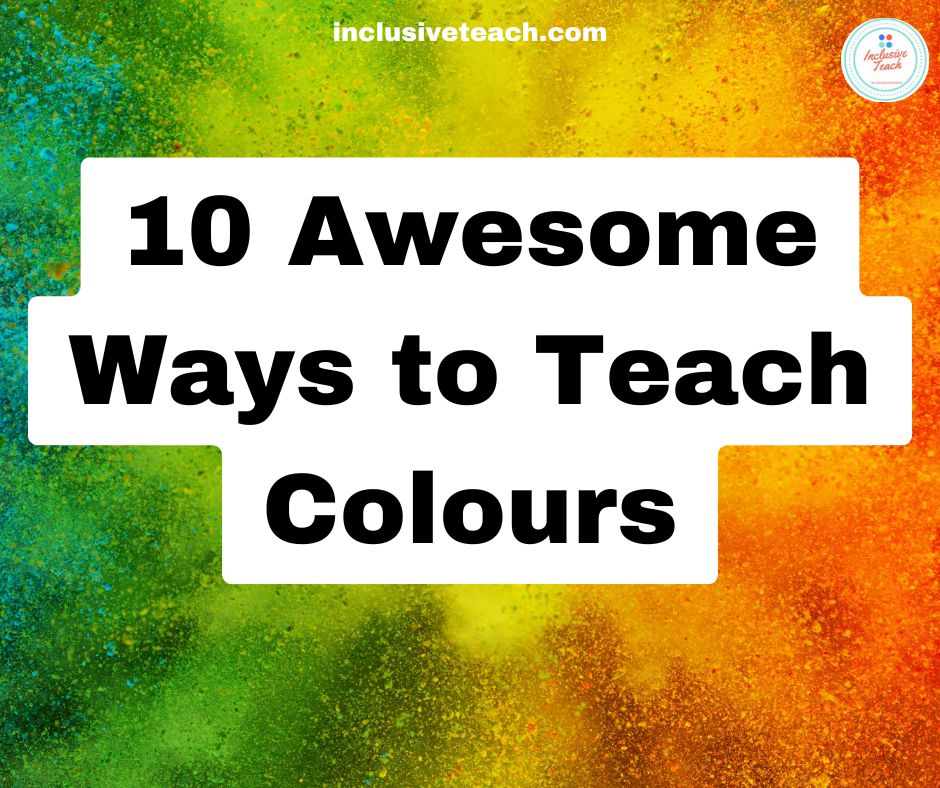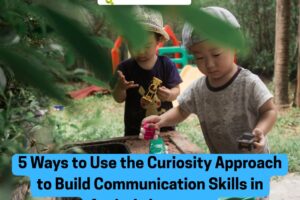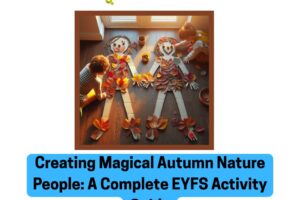
10 Awesome Ways to Teach Colours
Creative Ideas for Teaching Colours in the EYFS: Inclusive Strategies for All Learners
Teaching colours in the Early Years Foundation Stage (EYFS) is a joyful and multisensory experience, offering endless opportunities to support inclusion and neurodiversity. For children with Special Educational Needs (SEN), tailored approaches help ensure every learner can participate and thrive. Here are some tried-and-tested strategies shared by experienced teachers, adapted to promote engagement, sensory exploration, and communication. Sensory Story: Exploring Colours
1. Sensory Colour Exploration
Engage children in a hands-on discovery of colours using sensory-rich materials.
- Colour Bins or Sacks: Gather collections of items representing individual colours (e.g., red toys, green fabrics, yellow sensory balls). Allow children to explore these tactilely and visually, fostering discussion about similarities, differences, and associations.
- Visual Supports: Pair each item with laminated cards or photos, providing opportunities for matching and one-to-one correspondence.
- Makaton Signing: Enhance communication by introducing Makaton signs for each colour. Singing Hands’ video on colours is an excellent resource for this approach.
60+ Ideas for Teaching Colours using A Multi-Sensory Approach
Sensory Colour Activities
- Colour sorting boxes with textured materials
- Scented play dough in different colours
- Light table exploration with transparent objects
- Colour-changing water experiments
- Textured paint exploration
Movement-Based Learning
- Traffic light actions
- Colour scavenger hunts
- Rainbow yoga poses
- Colour-themed obstacle courses
Art Exploration
- Natural dye creation
- Rainbow collages
- Colour wheel spinning
- Ice painting
Food-Based Activities
- Fruit and vegetable colour sorting
- Rainbow snack preparation
- Colour-themed taste tests
- Food coloring experiments
- Colourful smoothie making
Nature and Outdoor Learning Connection
- Leaf matching
- Flower petal sorting
- Rainbow nature collections
- Sky colour observation
- Garden colour walks
Musical Elements
- Colour songs
- Rainbow percussion instruments
- Colour-coded music notes
- Musical movement with colours
- Sound and colour association games
Literacy Integration
- Picture book matching
- Colour story creation
- Environmental print colour hunts
Mathematical Links
- Colour pattern making
- Sorting by shade
- Counting coloured objects
- Shape-color combinations
- Graphing favourite colours
Science Experiments
- Colour mixing with light
- Rainbow water walking
- Crystal growing
- Prism exploration
- Colour absorption tests
Dramatic Play
- Colour-themed dress-up
- Rainbow shopping games
- Colour restaurant play
- Paint shop scenarios
- Colour monster role-play
Fine Motor Activities
- Colour sorting with tweezers
- Rainbow threading
- Colour matching puzzles
- Bead pattern making
- Colour coding with stickers
Social-Emotional Connection (Zones of Regulation)
- Colour mood associations
- Colour sharing activities
- Emotional colour wheels
Digital Integration
- Interactive colour or painting games/apps
- Digital colour mixing
- Photo colour hunts
- Colour recognition apps
- Virtual sorting by colours
Environmental Learning
- Classroom color labeling
- Colour-coded organisation of the classroom
- Rainbow reading corners
- Themed displays
- Environmental colour walks
2. Colour Hunts: Indoor and Outdoor Fun
Transform learning into a playful adventure by organizing a colour hunt.
• Nature-Inspired Hunts: Provide children with cards displaying various colours. Encourage them to find natural items (leaves, flowers, pebbles) that match the colours. Attach these to their cards using sellotape to create a tactile colour collage.
• Paint Strip Match-Up: Use paint sample strips to add an extra layer of challenge. Children can take photos of colour matches using tablets or iPads, fostering both fine motor and technology skills.
This activity works wonderfully in Forest School settings or as an outdoor exploration of seasonal colours.

3. Themed Circle Time: Colour of the Day
During your daily Circle Time introduce a daily focus on one colour to build familiarity and deepen understanding.
• Colour of the Day: Assign a colour to each day (e.g., Monday – red, Tuesday – orange). During circle time, children select toys or objects from a themed bag, promoting turn-taking and vocabulary development.
• Colour Tables: Create a morning display of items correlating with the day’s colour, inviting children to contribute or explore independently.
• Songs and Stories: Incorporate music and books themed around each colour, fostering auditory learning and imagination.
4. Attention Autism for Visual Learners
Inspired by the Attention Autism approach, use engaging visuals and clear demonstrations to teach colours.
• Bucket Sessions: Introduce bright, attention-grabbing props that represent each colour. Use repetition and enthusiasm to maintain focus.
• Interactive Experiences: Incorporate activities like painting or pouring colourful liquids into transparent jars for cause-and-effect learning.
Search platforms like TikTok for examples of Attention Autism sessions tailored to teaching colours.
@chloepmldteacher I think I’ll use coloured confetti next time🤣 #attentionautism #senteacher #teachertok ♬ Do Your Thing – Basement Jaxx
5. Multisensory Sessions: Linking Colours to Senses
Design sensory-rich lessons that help children associate colours with their environment.
- Colour and Smell: Use scented items (e.g., lavender for purple, lemon for yellow) to create a memorable sensory link.
- Texture and Touch: Include textured items like fluffy cotton balls for white or smooth pebbles for grey to support tactile exploration.
- Colourful Foods: If appropriate, use fruit and vegetables (e.g., red strawberries, green cucumbers) for an edible, multisensory experience.
6. Rainbow Rice Sensory Trays
Create vibrant, colourful sensory trays using dyed rice for a hands-on learning experience.
How to Set It Up: Dye uncooked rice in various colours using food colouring and let it dry. Divide the rice into sections in a large tray to resemble a rainbow.
Activity Ideas:
• Hide small objects in the rice for children to find and match to colour cards.
• Encourage children to mix colours and create their own “rainbow blends,” fostering fine motor skills and colour recognition.
Inclusive Tips: Provide sensory tools (e.g., scoops, funnels) for children who prefer not to touch the rice directly.
7. Colour Splatter Painting
Splatter painting is a messy yet exciting way to explore colours through art.
How to Set It Up: Lay out large sheets of paper or canvas and provide child-safe paints in primary colours. Use tools like brushes, sponges, or droppers for paint application.
Activity Ideas:
• Experiment with mixing colours by splattering two shades together and observing the results.
• Create group artwork by assigning each child a colour to splatter, promoting teamwork and inclusion.
Inclusive Tips: Offer alternatives such as adapted paintbrushes for children with motor difficulties.
8. Giant Floor Colour Games
Turn colour learning into a physical and cooperative activity.
How to Set It Up: Place large coloured mats, hoops, or fabric squares on the floor For smaller groups or 1:1 sessions you can use a twister mat.
Activity Ideas:
• Colour Hop: Call out a colour, and children hop to the matching mat.
• Sorting Race: Scatter coloured objects around the room and ask children to place them on the correct mat.
Inclusive Tips: Adapt the game for children with mobility challenges by allowing them to point to or throw soft objects at the mats instead.
9. Light and Shadow Colour Play
Introduce colours in a magical way using light and shadows.
How to Set It Up: Use a lightbox or a torch with coloured filters or transparent coloured shapes.
Activity Ideas:
• Mix two coloured filters together to explore colour combinations.
• Shine light through objects (e.g., coloured plastic blocks) to create patterns and shadows.
Inclusive Tips: Ensure the setup is accessible for all children, including those in wheelchairs or with visual impairments (e.g., using brighter contrasts).
10. Colour Story Time with Props
Enhance story time with colour-themed props for a rich sensory experience.
How to Set It Up: Choose a book focusing on colours (e.g., Elmer by David McKee or Brown Bear, Brown Bear by Eric Carle). Gather colourful props to represent key elements in the story.
Activity Ideas:
• Pass around props as the story progresses, encouraging children to interact with the items.
• Ask questions like, “What colour is this? Can you find something else that’s the same colour?”
Inclusive Tips: Include textured props for sensory input and use communication aids like Makaton or picture cards to support understanding.
Inclusivity in Action
When planning colour-based activities, consider the individual needs of each child:
- Sensory Sensitivities: Offer alternatives for children who may find certain textures overwhelming.
- Communication Needs: Use visual aids, signing, or AAC devices to support non-verbal learners.
- Small Group Options: Provide quieter, smaller group sessions for children who may find large groups challenging.
- Structured Activities: Use something like the TEACCH approach to create simple self contained practical activities to teach colours.

Final Thoughts
Teaching colours in the EYFS can be a dynamic and inclusive process, weaving sensory play, outdoor exploration, and tailored strategies to meet diverse needs. By embracing creativity and focusing on inclusion, educators can ensure all children develop a deeper understanding of colours while building communication, problem-solving, and sensory processing skills.
What are your favourite ways to teach colours? Share your ideas in the comments and let’s keep inspiring one another!
Related
Discover more from Special Education and Inclusive Learning
Subscribe to get the latest posts sent to your email.



